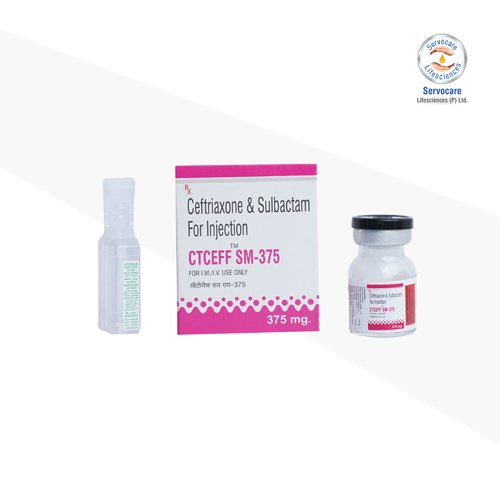Description
Ceftriaxone and Sulbactam injection are offered under the brand name CTCEEF SM-375, which is a potent antibiotic combination used to treat severe bacterial infections. Ceftriaxone, a third-generation cephalosporin, works by disrupting bacterial cell wall synthesis, while Sulbactam acts as a beta-lactamase inhibitor, enhancing its effectiveness against resistant strains. This injectable formulation is prescribed for infections like pneumonia, meningitis, sepsis, intra-abdominal infections, and complicated urinary tract infections.
This powerful antibiotic is manufactured by a top-notch healthcare company, Servocare Life Sciences. They manufacture a wide range of products in compliance with ethical quality standards. Their team of experts provides innovative formulations for their products. Servocare Life Sciences also offers PCD pharma franchise business opportunities in different locations of India.
Medical Benefits of Ceftriaxone and Sulbactam Injection
The medicinal advantages provided by Ceftriaxone and Sulbactam injection for the patients are mentioned below:
- Combines ceftriaxone’s broad-spectrum bactericidal activity with sulbactam’s beta-lactamase inhibition for enhanced efficacy.
- Effective against beta-lactamase-producing bacteria that resist standard antibiotics.
- Treats severe infections like pneumonia, meningitis, sepsis, and intra-abdominal infections.
- Intravenous/IM administration ensures quick therapeutic action in critical cases.
- Sulbactam protects ceftriaxone from enzymatic degradation, extending its antibacterial spectrum.
- Ideal for nosocomial (hospital-acquired) and post-surgical infections.
Storage Instructions for Ceftriaxone and Sulbactam Injection
The ways to store Ceftriaxone and Sulbactam injection are given here:
- Store at a temperature between 15°C and 25°C.
- Keep the solution away from direct sunlight and heat.
- Do not freeze the injection solution.
- Store in the original packaging to protect from light.
- Keep out of reach of children.
- Do not use after the expiry date printed on the label.
- Discard any unused portion safely after opening.
- Ensure the vial is not damaged or leaking before use.
Directions for Using Ceftriaxone and Sulbactam Injection
The directions in which the injection should be used are given below:
- Administer intravenously (IV) or intramuscularly (IM) as prescribed.
- Reconstitute with sterile water or compatible IV solution before use.
- For IV infusion, dilute further and administer over 30-60 minutes.
- Follow strict aseptic techniques during preparation and administration.
- Do not mix with calcium-containing solutions (risk of precipitation).
- Rotate injection sites for IM administration to avoid tissue irritation.
- Monitor for allergic reactions during and after administration.
- Complete the full course even if symptoms improve.
- Dosage adjustments may be needed for renal impairment.
- Avoid concurrent use with probenecid without medical advice.
- Discard any unused portion after reconstitution.
- Not for self-administration; use under medical supervision only.
Side Effects of Ceftriaxone and Sulbactam Injection
The side effects of Ceftriazone and Sulbactam injections are mentioned below:
- Nausea
- Vomiting
- Diarrhea
- Indigestion
- Rashes
- Itching
- Swelling
- Shortness of breath
Frequently Asked Questions (FAQs)
How is Ceftriazone and Sulbactam injection administered?
Given as an IV drip (30–60 minutes) or IM injection by healthcare professionals only.
How long does treatment last?
Typically 5–14 days, depending on infection severity and response.
Can Ceftriaxone and Sulbactam injection cause allergies?
Yes. Inform your doctor if you’re allergic to penicillin/cephalosporins.
Is Ceftriaxone and Sulbactam injection safe during pregnancy?
Only if clearly needed; consult your doctor for risk assessment.
What if I miss a dose?
Contact your healthcare provider immediately; do not double the dose.
Can Ceftriazone and Sulbactam injection interact with other drugs?
Yes (e.g., blood thinners, calcium-containing solutions). Share your medication list with your doctor.
Who should avoid Ceftriazone and Sulbactam injection?
Patients with severe penicillin/cephalosporin allergies or certain liver/kidney conditions.




